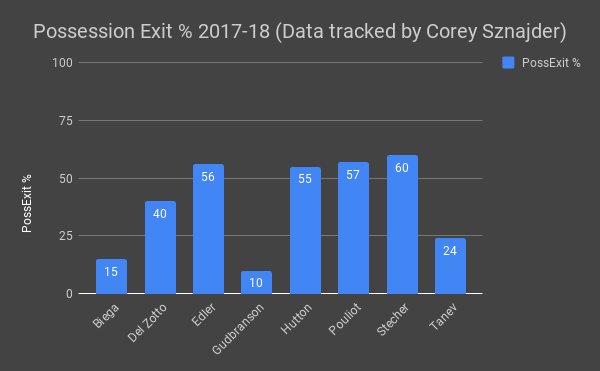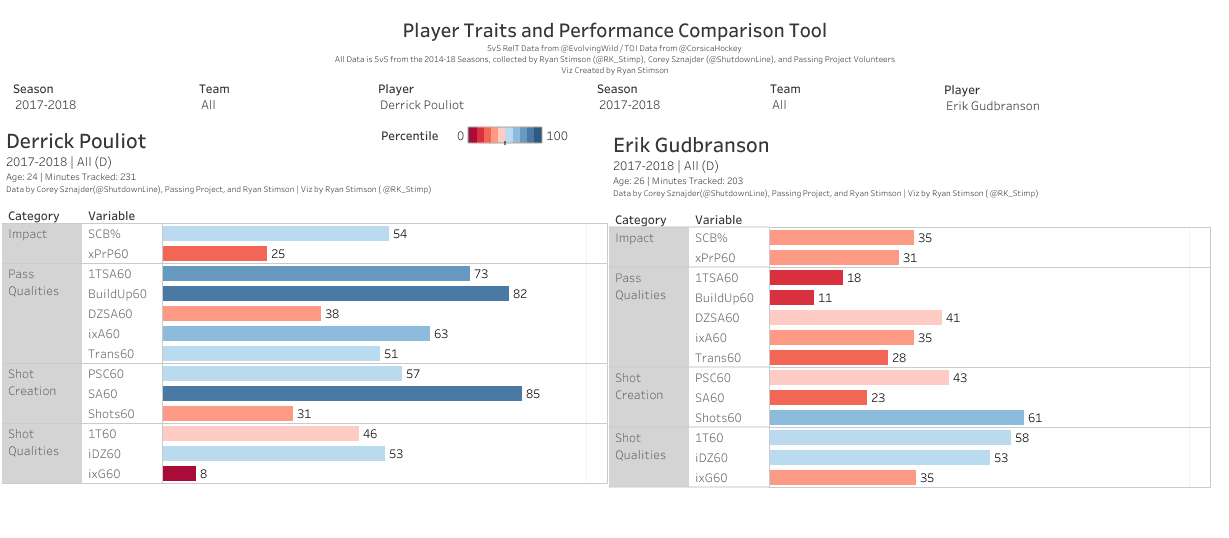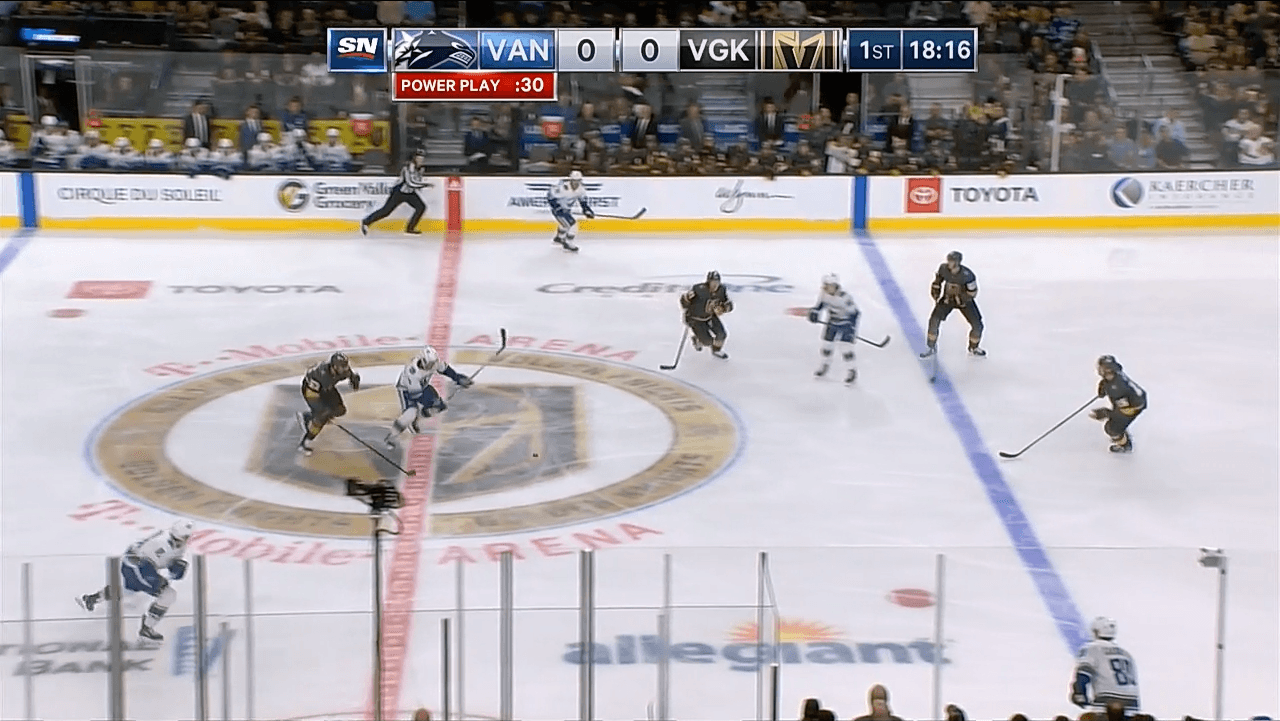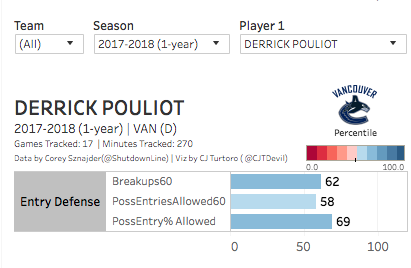Deep Dive: Breaking down why Derrick Pouliot’s game is so inconsistent

By Harman Dayal
5 years agoComing into this season trotting out the same blueline as last year, the Canucks needed some of the younger players on their backend to take a step forward.
More specifically, Travis Green was left wanting more from Ben Hutton and Derrick Pouliot.
“I thought Derrick and Hutty weren’t on top of their game (last year),” Green told reporters during training camp. “I told both those guys if they didn’t come back in better shape, they’d be seeing the same results.”
To their credit, each player arrived at camp noticeably fitter. For his part, Ben Hutton has reaped the immediate dividends – logging over 20 minutes a night and skating as the de facto top pairing defencemen on the left side with Alex Edler out of the lineup.
Hutton’s regained his confidence with the puck; making smart decisions to consistently orchestrate possession exits while using his stingy gap control and long reach without the puck to disrupt plays in the neutral zone.
With Derrick Pouliot, the results have been far more polarizing. After a disastrous training camp, Pouliot has seemingly returned to his inconsistent fashion – coupling flashes of brilliance with unforgivable mistakes costing the team goals against.
A glance at the on-ice data insinuates that the pros have outweighed the cons to date – the Canucks receiving a sizeable boost in terms of the ratio of shot attempts, scoring chances and goals they control with the 24-year-old on the ice.

Pouliot is a whopping four percent up on the second-highest defenceman, Troy Stecher, in controlling north of 50% of shot attempts. The results have translated in the form of actual and expected goals alike to boot.
As impressive as that sounds, context is certainly working to Pouliot’s advantage. The former first-round pick is receiving the highest ratio of offensive zone starts on Vancouver’s back end while facing the most favourable matchups in terms of quality of competition.

The effects of quality of competition tend to normalize over the course of a season, but it’s a big piece of the puzzle in smaller sample sizes. It’s a major factor in explaining Alex Edler and Chris Tanev’s horrific underlying stats to date and undoubtedly plays a significant part in Pouliot’s promising numbers too.
Keeping this in mind, it’s crucial we shift our focus to both the eye test and the larger sample of information we gained from last year’s campaign to establish an informed assessment of what the team has in Pouliot. In fact, when you couple these tools it’s easy to identify patterns that may give clues as to why Pouliot’s level of play varies so drastically through stretches of the season.
High-risk, high reward breakouts
When Derrick Pouliot leads a breakout more often than not there are two outcomes: a possession exit, or a turnover.
On the one hand, Pouliot finished last season as the only Canuck defenceman other than Troy Stecher and Alex Edler to crest the 55th percentile of NHL defencemen for possession exits in Corey Sznajder’s tracked sample.

Unfortunately, that proficiency has come at a steep cost. Within that same dataset, Pouliot stands out for all the wrong reasons. He’s third-worst on the team in failed exits and clearances per hour and owns a fail percentage lower than only Erik Gudbranson and Alex Biega.

While we don’t have zone exit data for this season yet, there have already been a couple of instances where Pouliot’s turnovers have cost the team dearly. When examining the tape from both this season and years past, it’s clear that these issues stem from sloppy puckhandling while reading the developing play.
As the first clip can attest, Pouliot has struggled since he first emerged into the NHL at keeping up with the increased pace and intensity of the big leagues. He gets caught in these situations because he’s too slow in processing the play and making a breakout decision.
On the other hand, Pouliot possesses composure with the puck on his blade and passing accuracy that few others on the team can boast.
Notice in the above compilation how Pouliot can hang onto the puck for a split second longer to commit the forechecker and create space for the player receiving the pass.
Ultimately, this means that Pouliot excels so long as there’s a readily available, obvious breakout option. Apply heavy forechecking pressure and make the passing decision difficult though, and you’ll see him start to panic.
Overrated Offensive Play
Everyone sees 22 points in 71 games and assumes that Derrick Pouliot did well offensively last season. I’d argue he was largely abysmal in that regard outside of the powerplay.
Seven of Pouliot’s 12 even-strength points came via secondary assists, which as we know are mostly random and usually unrelated to one’s actual influence on the goal.
In fact, Pouliot’s five even-strength primary points from last season are just one more than Erik Gudbranson. Account for ice-time and Pouliot’s primary points rate ranks 194th out of 212 qualified blueliners.
The lack of even-strength production wasn’t a luck related factor either – Ryan Stimson’s passing project, which looks at how individual players drive offensive sequences in the offensive zone, painted an equally grim outlook.

The key metric to look at is expected primary points. This stat estimates the even-strength primary points a player should have registered based on how they drive passes and shots conducive for scoring. Pouliot ranked among the bottom 25th percentile of the league’s defencemen. This tells us that he’s struggled to distribute the puck to players in scoring areas.
When exploring the root cause of this problem, I’m left skeptical of Pouliot’s offensive vision – particularly on offensive entries.
In each of the above clips, Pouliot makes a poor entry decision despite having winger support to defer to. The Vegas example is particularly egregious as he loses the puck despite having Adam Gaudette wide open for an easy entry on the right side.

The lack of offensive success has been more pronounced this season where Pouliot’s registered just two points in 14 games.
Aggressiveness is the key to Pouliot’s success
While he may not drive offence on his own, Pouliot can still find success in a sheltered role on a bottom pairing if he keeps up with his defensive play.
Last season, Pouliot was particularly effective in snuffing out the opposition’s counterattacks – one of the few Canuck defencemen to own an above average zone entry defence profile.

Viz by CJ Turtoro, data courtesy Corey Sznajder
Pouliot’s at his best when he’s aggressive in anticipating and stepping up on the play. From there, he couples that tight gap control with adept stickwork that lets him break up the opposition’s rush and win puck battles along the boards that he’d usually concede if it became a physical battle. Pouliot was especially effective last season when playing alongside Alex Edler – who’s passive defensive approach afforded the former the freedom to make aggressive pinches all over the ice.
Failed to load video.
In terms of own zone coverage, he seems to have taken a book out of Troy Stecher’s page with regards to hounding the puck like a dog on a bone and using the boards to separate the man from the puck.
Conclusion
Derrick Pouliot’s processing speed and vision hold him back from being a premier offensive defenceman, but he can still drive positive two-way results when on top of his game.
Inconsistency continues to plague Pouliot who’ll need to cut back on his turnovers and maintain an aggressive, up-tempo defensive style to stick not only with the Canucks but in the NHL as a whole.
Recent articles from Harman Dayal





